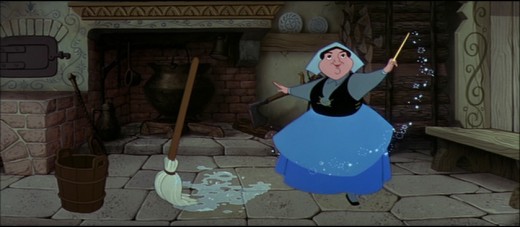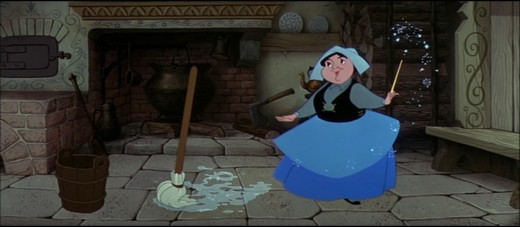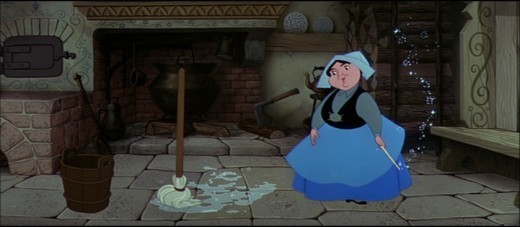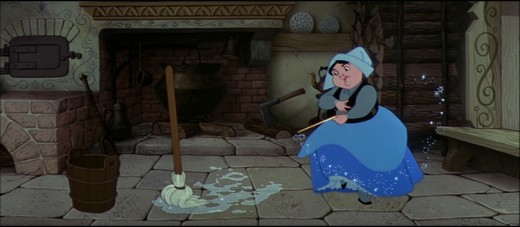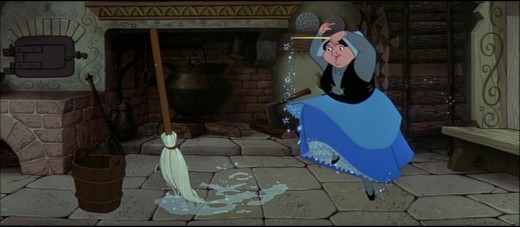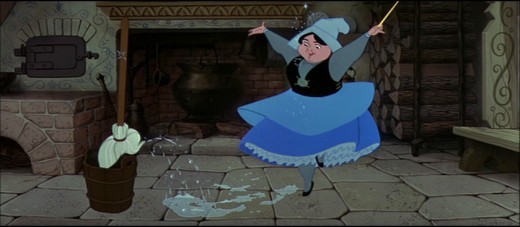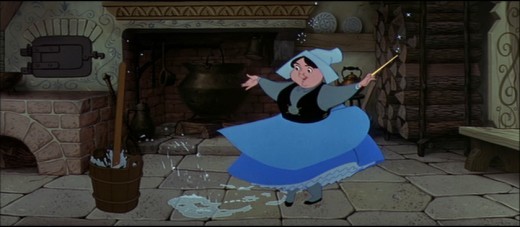Search ResultsFor "eyvind earl"
Animation Artifacts &Daily post 15 Jan 2007 08:59 am
A Bit of History
- Back in the mid-Fifties, a young boy, I was a fan of several people in the Disney studio. Like any kid who was a fan 3000 miles from a movie studio, I sent fan letters to my stars. Eyvind 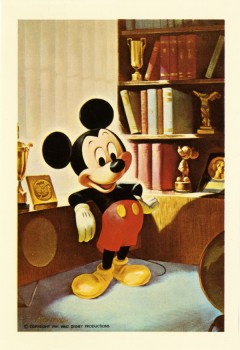 Earle, Joshua Meador, Marc Davis and others received my kid fan mail. Maybe once every four or five months I’d send off another letter.
Earle, Joshua Meador, Marc Davis and others received my kid fan mail. Maybe once every four or five months I’d send off another letter.
I started getting postcards back from what I presume was the mailroom at the studio. Just as Lana Turner would have sent back an 8×10 glossy with a signature by someone, the Disney studio sent out postcards.
Somehow, none of these were saved. I recently found one such card on ebay and sucked it for memorabilia’s sake. This card, to the left, is smaller than the ones originally sent out, but the picture’s the same. I remember one which was very different. It must have had fifty characters in it – a lot of the feature characters (somehow I remember Brer Rabbit) – were set within drawn frames and gathered on this card. That’s right, about fifty frames on a little card – maybe 5×7 – so all the characters were small. Just right for a kid’s small hands.
.
(Click on images to enlarge.)
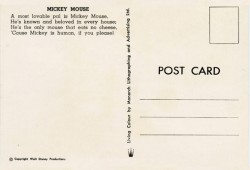 There was always some innocuous writing on the back of the card. “Best wishes from Walt Disney,” or some such phrase. After the first card, I lost interest in the printed signature. Anyway, I had sent my letter to Ward Kimball; why did Disney sign it!
There was always some innocuous writing on the back of the card. “Best wishes from Walt Disney,” or some such phrase. After the first card, I lost interest in the printed signature. Anyway, I had sent my letter to Ward Kimball; why did Disney sign it!
My favorite return was something I’d gotten from a letter sent to Joshua Meador.
Aside from the postcard there was a xerox copy of an article written in 1933. “The History of the Animated Cartoon” by Earl Thieson was written for the journal of the Society of Motion Picture Engineers. A nicely printed copy of the article was sent to me anonymously. It took a while to see that the document was written so early and excluded 2/3 of the history of animation that I knew. It made me feel that my one fan letter had hit home and was read by someone other than the studio gate guard.
- Yesterday, the New York Times featured an article about comic strip collectors and shows how some individuals are helping to save a medium that is in danger of dying. Gasoline Alley serves as the example of strips that are kept alive by these fans. You can purchase volumes of Gasoline Alley from Drawn and Quarterly or Amazon.
Animation &Animation Artifacts 28 Sep 2006 08:16 am
Merryweather Followup
- Here’s a followup to yesterday’s Merryweather dance. These are the frame grabs from the scene in the cottage featuring the Frank Thomas drawings posted yesterday.
Frank Thomas often complained about Eyvind Earle’s color design. He disliked the fact that the fairies had a black bodice. He was especially peeved over this sequence, and I heard him talk about it at least three times. He felt this anchored them to much to the ground and weighed them down. I’m not sure I agree with him; I think the character moves beautifully and retains the weightlessness he sought.
Books &UPA 04 Sep 2006 09:45 am
Cartoon Modern
- I hope I’m not sounding like a shill, but I don’t really mind. I believe in the product, and I’m going to broadcast my enthusiasm until you’ve got tears in your eyes.
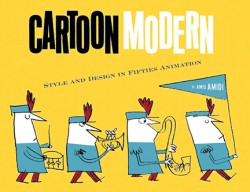 Amid Amidi’s book Cartoon Modern is the best book on animation I’ve encountered since Michael Barrier’s Hollywood Cartoons.
Amid Amidi’s book Cartoon Modern is the best book on animation I’ve encountered since Michael Barrier’s Hollywood Cartoons.
When Barrier’s book came out, I was depressed and could find no inspiration in anything animated. As a matter of fact, I didn’t want to see any more animated films. I read his book and found the charge I was looking for. I reread the book and found more. Just getting some trustworthy version of some of the pioneers and artists who pushed their way through the medium did it for me. I found new life in the work I did after that. I reread that book at least once a year – just for the pleasure.

(An Eyvind Earle study for Sleeping Beauty.) . . . (All images enlarge by clicking.)
Cartoon Modern has had a similar effect. The story, here, isn’t about the pioneers who built a business and an artform; it’s about the artists who rebelled from that business to advance the art. Their story is every bit as thrilling and certainly as much of an inspiration. This is especially so in that I grew up while these guys developed the look they advanced. In some small way I was taught – through their cartoons – that modern art was good. Also, as a small business animator, how could I not associate with these guys?
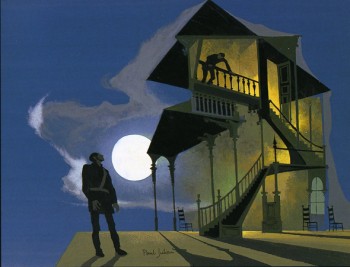 This book is filled with glorious illustrations as only such a story could be told. We are talking about people who found a way to update the art and break the mold of the 19th Century.
This book is filled with glorious illustrations as only such a story could be told. We are talking about people who found a way to update the art and break the mold of the 19th Century.
I’ve recklessly copied a couple of the stills from the book to illustrate how magnificent Amid’s photo research is to illustrate his text. It involved more than going to one archive and having them open their wares to you.
(Paul Julian’s painting for UPA’s “The Telltale Heart.”)
Amid had to go to many artists who shared the wealth. That, let me tell you, is a trying job. None of the difficulty is apparent here. Just the love. Love of the material and the medium.
Amid Amidi has a lot in common with Michael Barrier. 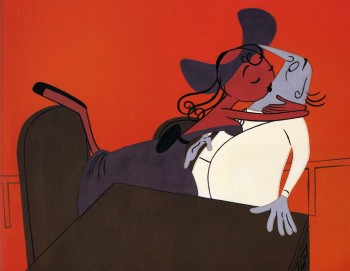
They’re both fine writers, articulate and intelligent. Both are in love with the medium, and neither is afraid to call a spade a spade or a bad cartoon a bad cartoon. You don’t always have to agree with them, just agree to listen.
For this quality, as a writer, you have to have more than a little responsibility.
Your sense of taste has to be impeccable and your audience has to trust you.
(Cel set-up from “Rooty Toot Toot.”)
Amid gained my trust and my affection for his writing years ago – thank heaven for the internet! Animation Blast, Cartoon Modern (the website), and Cartoon Brew have all informed me in a deep and solid way.
My delight in this book couldn’t be more sincere.
I haven’t completely finished reading it, and I do have a couple of quibbles. But that would have been the case of any book. However, this book is all about taste, and I’m so pleased to be in the hands of such a fine writer and historian – it’s a great feeling.
Puppet Animation &Trnka 18 Jun 2006 08:31 am
The Hand
As you can tell, from some of my recent postings, I have always had a love affair with puppet animation. There’s something extraordinary about that medium that has drawn me in. I’ve always demanded a tactile approach to animation, including all of the 2D work I’ve done.
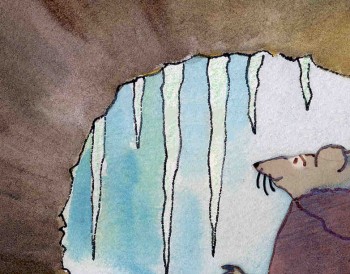 I remember seeing Lady & The Tramp in 1955, on its first release (I was nine.) It was then that I consciously noted that one of the backgrounds in the “Bella Notte” sequence (I can now see that it was an Eyvind Earle BG) had texture in its paper. The board it was painted on came through the animation photography and reached out to me. The human hand became evident in the film.
I remember seeing Lady & The Tramp in 1955, on its first release (I was nine.) It was then that I consciously noted that one of the backgrounds in the “Bella Notte” sequence (I can now see that it was an Eyvind Earle BG) had texture in its paper. The board it was painted on came through the animation photography and reached out to me. The human hand became evident in the film.
Perhaps, this was what I loved so much about animation in the first place. Humans did it, and it was self-evident. Being reminded of it, in the subtlest ways – usually unintentional, added to my joy.
Perhaps this is what brought me to John Hubley’s films. Those films were so obviously painted: characters and BG were both used by the photographer to combine for us, and the unintentional was often caught on screen. (I immediately loved those highlighted rings double-exposed around the characters in Moonbird, the brush strokes of The Hole, the transparency of the characters’ paper in Of Stars and Men.) It added to the experience.
In a sense, I was brought out of the film but held in it and given the opportunity to love it even more.
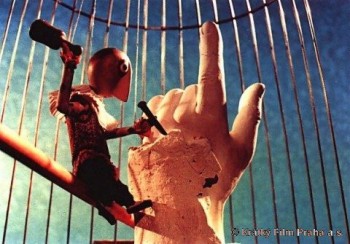 I’ve had this same sense with the best 3D animation. Though I was always there viewing it, I was also caught up in the emotions of the film. Trnka’s masterful film, The Hand, had my understanding those tears and sweat on the little potter were moistened ink that had been his painted eyes. But the anguish I felt the first time I saw the film and that effect has never left me. The perfections of the Human Hand in that film forced the imperfections of the puppet potter to be revealed until it destroyed him.
I’ve had this same sense with the best 3D animation. Though I was always there viewing it, I was also caught up in the emotions of the film. Trnka’s masterful film, The Hand, had my understanding those tears and sweat on the little potter were moistened ink that had been his painted eyes. But the anguish I felt the first time I saw the film and that effect has never left me. The perfections of the Human Hand in that film forced the imperfections of the puppet potter to be revealed until it destroyed him.
Perhaps this is also what keeps me from embracing cgi animation. Despite the faked textures of the computer, it’s so obvious that it is not real. At least not when the characters are cartoons.
A very small example of what I’m trying to communicate stands out for me in Cars. The paint job of newer cars has a flecking/speckling of glitter within the paint. In the right light, the main character, Lightning McQueen, had this paint job. Everytime I saw it, I was distracted and pulled out of the film. Like the real paint on a real car, that flecking was embedded within the paint, itself. It didn’t feel like the byproduct of a human hand; it felt like a computer trick.
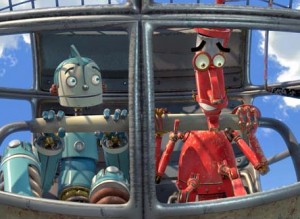 I am no more capable of coloring the computer skin of that computer hand than I am of painting a real car. It isn’t tactile for me, it’s just distracting.
I am no more capable of coloring the computer skin of that computer hand than I am of painting a real car. It isn’t tactile for me, it’s just distracting.
It’s just something I never feel I can reach out and touch. This is something that has been overcome, for me, in a couple of films. The Incredibles gets very close often. Moments of Robots, such excellent design for the medium. Some of Toy Story.
(Click on any image to enlarge and enjoy the textures.)
Of course, I recognize that this is my problem. However, I recognize it’s a problem that other people probably have and wonder if there isn’t a solution. In The Iron Giant, the Giant is animated by a computer. I was told that the animation had to be rigged to be animated on “two’s” so that it wouldn’t separate from the rest of the hand-drawn animation. Oddly, it felt totally acceptable to me; I saw no problem and accepted that robot. There has to be, in there, a way to resolve it – I’m just thinking here and don’t expect anyone to try to follow what I’m saying. Perhaps if “human” problems, technical problems, were added to the animation. . . No this is even too stupid for me.
Animation Artifacts 29 Apr 2006 08:54 am
Paul Bunyan
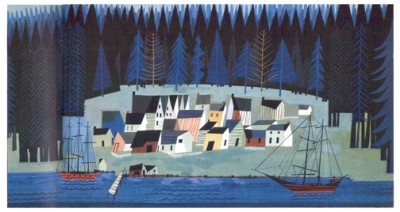 - On May 22,
- On May 22,
the NY chapter of the MPAcademy will present their monthly screening, Monday nights with Oscar. This month they are showing The Defiant Ones, starring Sidney Poitier and Tony Curtis.
(Image scanned from Bob Thomas’ 1959 Art of Animation)
Of more interest to animation enthusiasts is the short playing with that film: Paul Bunyan. This 17min short was nominated for the Oscar in 1958. 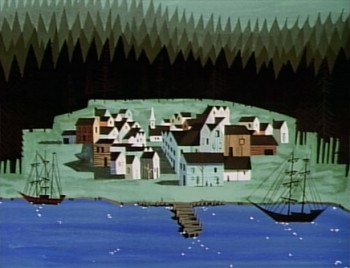 It’s been shown on television often enough, and was recently included in the dvd collection, Disney Rarities – Celebrated Shorts, 1920s – 1960s. (I find the transfer on the DVD high contrast, and not the best quality.) This is the first time I can remember a theatrical screening of the film.
It’s been shown on television often enough, and was recently included in the dvd collection, Disney Rarities – Celebrated Shorts, 1920s – 1960s. (I find the transfer on the DVD high contrast, and not the best quality.) This is the first time I can remember a theatrical screening of the film.
With strong designs by Tom Oreb and stunning backgrounds by Eyvind Earle, it’s a chance to see one of the best animated theatrical films of the 50′s.
(Image taken from Disney Rarities DVD.
Click either image to enlarge.)
The 1958 Oscar winning live action short, Grand Canyon, also from Disney, is on the program as well.
May 22nd at 7pm, at the Academy Theater at Lighthouse International, 111 East 59th St. Tickets are $3 for Academy members and $5 for the general public. Call 1-888-778-7575 to buy tickets in advance.
Animation Artifacts &Commentary 03 Apr 2006 07:16 am
2 Beauties
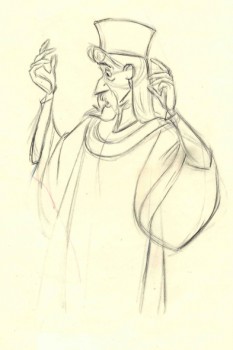 – My favorite site in the last week has definitely been Amid Amidi’s Cartoon Modern. He has been posting a lot of models from Rooty Toot Toot which are just amazing.
– My favorite site in the last week has definitely been Amid Amidi’s Cartoon Modern. He has been posting a lot of models from Rooty Toot Toot which are just amazing.
Then to break from that film, he gave us Eyvind Earle Bg models for Sleeping Beauty. The artwork posted has been beyond inspirational, and the comments given to Amid are also strong. I hadn’t realized how many people didn’t like Sleeping Beauty. I’d always thought Earle’s Bg styling and Tom Oreb’s angular characters were a perfect match. Since half of the design of tv animation and movies like Pocahontas have ripped into Eyvind Earle’s work, it interests me to see how many people blame him for the film’s failure – if there is one.
The site has provoked argument and information. It’s extraordinary always to see how other people think and feel about these classic films. I love reading it all, and the artwork is sensational. Kudos Amid. This site has become a must visit, daily.
Daily post 31 Mar 2006 07:49 am
Bicoastal AMPAS Screenings
Jerry Beck on Cartoon Brew appropriately applauds the Motion Picture Academy for resuming their series of films that won the Best Picture awards and usually includes winners & nominees for short subjects. The has also been true of the NY chapter of the Academy. 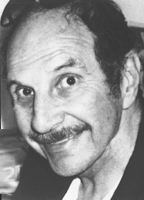
– NY screenings are open to the public and have had some success with packed houses. Thanks to the incredibly diligent work of Patrick Harrison, the prints have been superb, and there is almost always a guest to talk about the film. There has been no break in this series, and each month there’s been a classic screening to look forward to.
On April 10th HUD will be screened; Patricia Neal will be interviewed by TCM’s Robert Osborne. The Ernest Pintoff short, The Critic, will be screened. Unfortunately, Mel Brooks, who doesn’t quite narrate, but comments – won’t be there.
(Ernest Pintoff)
-
Tickets for the screening are $5 for the general public and $3 for Academy members and students with a valid I.D. and may be reserved over the phone by calling 1-888-778-7575. For more info go to: Oscars.org.
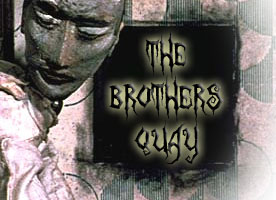
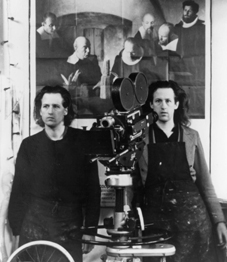 - People in LA also have a treat coming April 21st. The Brothers Quay will talk about their films in a personal appearance. This is something of a rare event, and it’ll be interesting to hear what they have to say.
- People in LA also have a treat coming April 21st. The Brothers Quay will talk about their films in a personal appearance. This is something of a rare event, and it’ll be interesting to hear what they have to say.
Again, tickets are $5 for the general public and $3 for Academy members and students and will be available after April 1. For more information go to the Academy site.
.
- Amid Amidi has been busy today writing two excellent pieces on films & artists that inspire me. On Cartoon Modern, there’s a sampling of artwork and a thesis about Eyvind Earle’s work on Sleeping Beauty. On Cartoon Brew, there’s a link to view Yuri Norstein‘s masterful short, The Heron and the Crane. Enlighening and inspirational; worth the visits.
- Reviews (mixed but generally positive) are out for Ice Age 2. To read a few:
The NY Times
The LA Times
Roger Ebert
The NY Daily News
Commentary &Puppet Animation 27 Dec 2005 07:48 am
#4
Continuing my “Best of . . .†list: (films, sites, books or works of art that inspired me or caused me to at least think in a new way about the animation) #4 is a tie going to the two puppet animated features: The Corpse Bride and Wallace & Gromit in The Curse of the Were-Rabbit. If you took the two and merged them into one, I think you’d come up with something great.
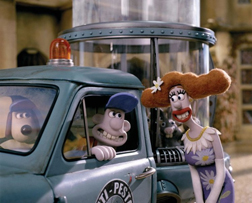 There is in the Nick Park work some magnificent invention and detail. His film is generally charming and inventive, but it came off a bit light to me. His casting is dead-on: the voices of Ralph Fiennes and Helena Bonham Carter were hilarious and were well exploited in the visuals. There’s a lot of well-developed character in the clay animation. It has a lightness to it despite the clay’s weight, and any cgi used was well hidden and well done.
There is in the Nick Park work some magnificent invention and detail. His film is generally charming and inventive, but it came off a bit light to me. His casting is dead-on: the voices of Ralph Fiennes and Helena Bonham Carter were hilarious and were well exploited in the visuals. There’s a lot of well-developed character in the clay animation. It has a lightness to it despite the clay’s weight, and any cgi used was well hidden and well done.
However, in a feature film, I look for a greater story. The film was lacking that under-story which would have made it deeper and richer. Unfortunately, this is a complaint that I could make for most of the films produced today – not just the animated films.
Tim Burton‘s The Corpse Bride had plenty of under story but was lacking in the story, itself. It was a simple Russian tale told with lots of complications but never felt complete.
The voices were well cast, and the acting was superb; Emily Watson and Albert Finney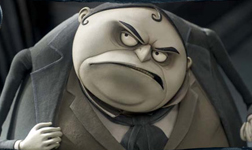 were exceptionally good. The animation showed some bits of character, but I wasn’t taken by most of it. Too often it felt like I was watching puppets, and I never got into the head of any of them or felt any of them alive. However, it is probably the most stunningly Art Directed puppet film ever done. This is all I think about when I try to remember the film. If only the Oscars would take notice of animation in such categories as Production Design. Perhaps Eyvind Earle might have been nominated once upon a time. (The one fault I felt was design of some of the characters: too many with hunched backs.) Otherwise, this film’s design certainly stands up with the best – live action or animated.
were exceptionally good. The animation showed some bits of character, but I wasn’t taken by most of it. Too often it felt like I was watching puppets, and I never got into the head of any of them or felt any of them alive. However, it is probably the most stunningly Art Directed puppet film ever done. This is all I think about when I try to remember the film. If only the Oscars would take notice of animation in such categories as Production Design. Perhaps Eyvind Earle might have been nominated once upon a time. (The one fault I felt was design of some of the characters: too many with hunched backs.) Otherwise, this film’s design certainly stands up with the best – live action or animated.
I felt more inspiration in these two puppet animated films than I did from any other cgi film. In both you could feel the fingerprints of the animators in the life of their puppets. Someone touched the objects on the screen, and that helped them breathe.

